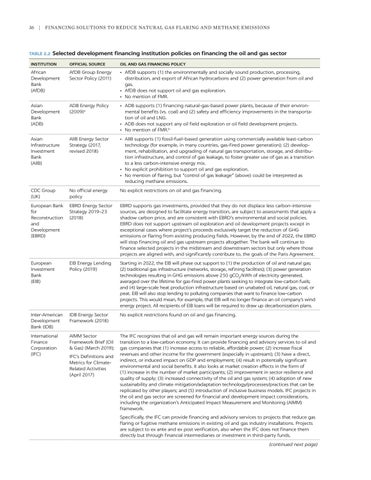36
| Financing Solutions to Reduce Natural Gas Flaring and Methane Emissions
TABLE 2.2
Selected development financing institution policies on financing the oil and gas sector
INSTITUTION
OFFICIAL SOURCE
OIL AND GAS FINANCING POLICY
African Development Bank (AfDB)
AfDB Group Energy Sector Policy (2011)
• AfDB supports (1) the environmentally and socially sound production, processing, distribution, and export of African hydrocarbons and (2) power generation from oil and gas. • AfDB does not support oil and gas exploration. • No mention of FMR.
Asian Development Bank (ADB)
ADB Energy Policy (2009)a
• ADB supports (1) financing natural-gas-based power plants, because of their environmental benefits (vs. coal) and (2) safety and efficiency improvements in the transportation of oil and LNG. • ADB does not support any oil field exploration or oil field development projects. • No mention of FMR.b
Asian Infrastructure Investment Bank (AIIB)
AIIB Energy Sector Strategy (2017, revised 2018)
• AIIB supports (1) fossil-fuel–based generation using commercially available least-carbon technology (for example, in many countries, gas-fired power generation); (2) development, rehabilitation, and upgrading of natural gas transportation, storage, and distribution infrastructure, and control of gas leakage, to foster greater use of gas as a transition to a less carbon-intensive energy mix. • No explicit prohibition to support oil and gas exploration. • No mention of flaring, but “control of gas leakage” (above) could be interpreted as reducing methane emissions.
CDC Group (UK)
No official energy policy
No explicit restrictions on oil and gas financing.
European Bank for Reconstruction and Development (EBRD)
EBRD Energy Sector Strategy 2019–23 (2018)
EBRD supports gas investments, provided that they do not displace less carbon-intensive sources, are designed to facilitate energy transition, are subject to assessments that apply a shadow carbon price, and are consistent with EBRD’s environmental and social policies. EBRD does not support upstream oil exploration and oil development projects except in exceptional cases where project’s proceeds exclusively target the reduction of GHG emissions or flaring from existing producing fields. However, by the end of 2022, the EBRD will stop financing oil and gas upstream projects altogether. The bank will continue to finance selected projects in the midstream and downstream sectors but only where those projects are aligned with, and significantly contribute to, the goals of the Paris Agreement.
European Investment Bank (EIB)
EIB Energy Lending Policy (2019)
Starting in 2022, the EIB will phase out support to (1) the production of oil and natural gas; (2) traditional gas infrastructure (networks, storage, refining facilities); (3) power generation technologies resulting in GHG emissions above 250 gCO2/kWh of electricity generated, averaged over the lifetime for gas-fired power plants seeking to integrate low-carbon fuels; and (4) large-scale heat production infrastructure based on unabated oil, natural gas, coal, or peat. EIB will also stop lending to polluting companies that want to finance low-carbon projects. This would mean, for example, that EIB will no longer finance an oil company’s wind energy project. All recipients of EIB loans will be required to draw up decarbonization plans.
Inter-American Development Bank (IDB)
IDB Energy Sector Framework (2018)
No explicit restrictions found on oil and gas financing.
International Finance Corporation (IFC)
AIMM Sector Framework Brief (Oil & Gas) (March 2019);
The IFC recognizes that oil and gas will remain important energy sources during the transition to a low-carbon economy. It can provide financing and advisory services to oil and gas companies that (1) increase access to reliable, affordable power; (2) increase fiscal revenues and other income for the government (especially in upstream); (3) have a direct, indirect, or induced impact on GDP and employment; (4) result in potentially significant environmental and social benefits. It also looks at market creation effects in the form of (1) increase in the number of market participants; (2) improvement in sector resilience and quality of supply; (3) increased connectivity of the oil and gas system; (4) adoption of new sustainability and climate mitigation/adaptation technology/processes/practices that can be replicated by other players; and (5) introduction of inclusive business models. IFC projects in the oil and gas sector are screened for financial and development impact considerations, including the organization’s Anticipated Impact Measurement and Monitoring (AIMM) framework.
IFC’s Definitions and Metrics for ClimateRelated Activities (April 2017)
Specifically, the IFC can provide financing and advisory services to projects that reduce gas flaring or fugitive methane emissions in existing oil and gas industry installations. Projects are subject to ex ante and ex post verification, also when the IFC does not finance them directly but through financial intermediaries or investment in third-party funds. (continued next page)


